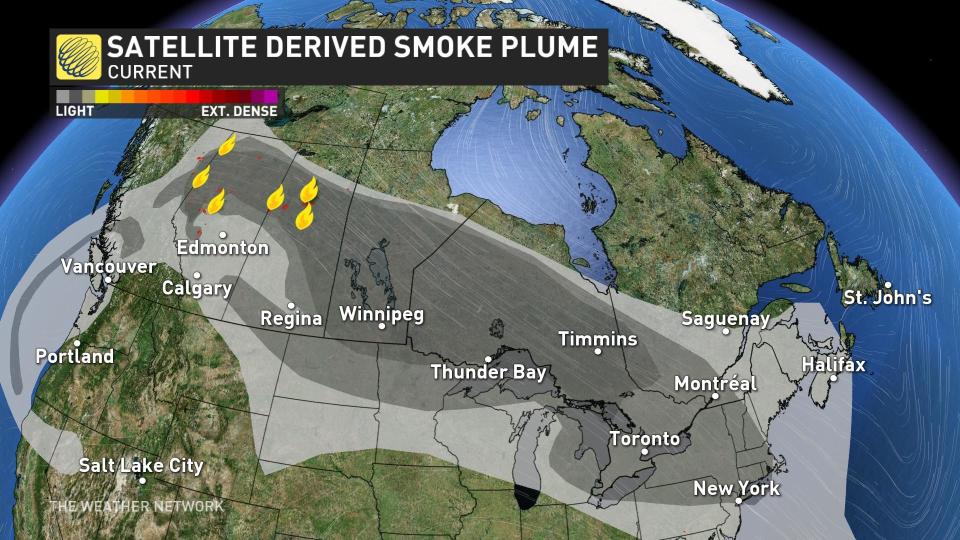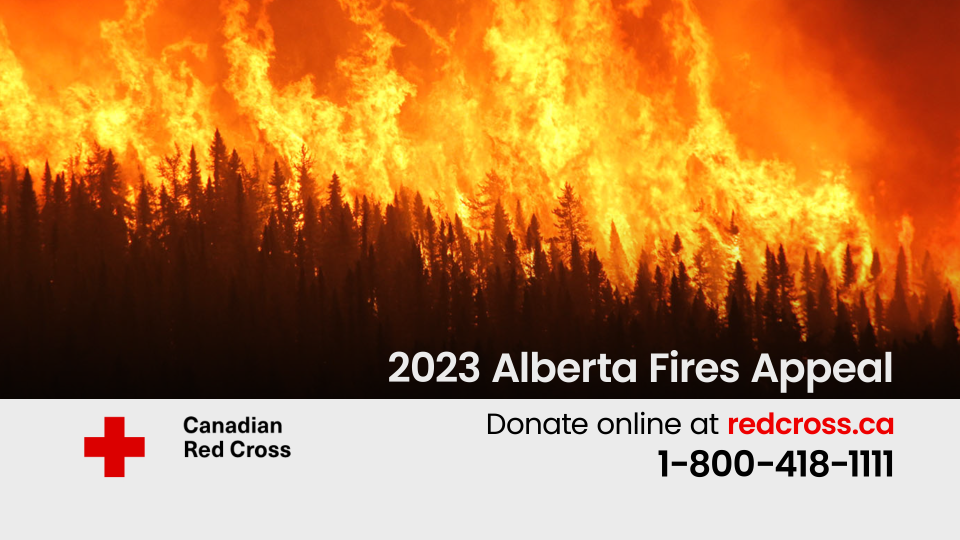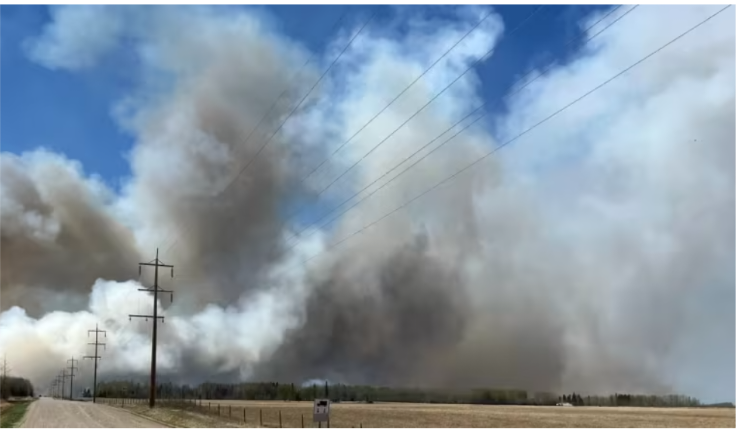Health issues may arise from wildfire smoke pushing into Eastern Canada
Thick wildfire smoke pouring out of the heat-baked western provinces is moving east in the coming days and will fill the skies over parts of Ontario, Quebec, and the Maritimes. As of Monday evening, smoke was wafting in across Ontario.
The amount of smoke produced by the intense fires will make for more than just some photogenic sunsets, potentially leading to health problems for vulnerable people as we progress through this week. Northern Ontario and pockets of southern areas may see some degradation of air quality, as it's possible some smoke will be able to mix to the surface across some regions.
STAY PREPARED: How to ensure your safety during wildfire season
A glance at visible satellite imagery on Monday evening reveals a thick blanket of wildfire smoke migrating over Ontario.

A satellite view of western North America on May 14, 2023, showing dense wildfire smoke over northwestern Canada. (NOAA)
The greatest concentration of fires exists in the northern half of Alberta, where officials reported nearly 90 active fires burning as of Monday afternoon. There are also wildfires burning in northeastern British Columbia, northern Saskatchewan, and the N.W.T., all of which are pouring additional smoke into the atmosphere over the region.
This smoke won’t stay put for long. A strong jet stream over the northern half of the country will transport much of that smoke toward the eastern provinces, at times thick enough to blot out blue skies and create ample haze for millions.

The latest model guidance suggests that this smoke will quickly spread east through the coming days, reaching communities in parts of Ontario and Quebec before moving on to blanket a large swath of the Maritimes.
By the middle of the week, we could see a veil of smoke covering the country from Vancouver Island to Nova Scotia.
Not all of this smoke will remain in the upper levels. A wind shift in Alberta will likely send low-level smoke blowing toward Edmonton and Calgary, potentially leading to dangerous air quality levels for folks living with respiratory conditions like asthma and chronic obstructive pulmonary disease (COPD).
WATCH: Does breathing in wildfire smoke mean lung issues for life?
Coping with wildfire smoke
If you’re especially vulnerable to the effects of wildfire smoke, it’s worth taking a few extra steps this week to ensure your safety and comfort.
RELATED: How to protect yourself from unhealthy air during wildfire season
Monitor current and predicted air quality values in your community, planning activities around times when wildfire smoke particulates are expected to rise above healthy levels.

Experts with Health Canada recommend limiting outdoor activities during those times, as well as keeping windows securely sealed, using indoor air purifiers, and even staying well-hydrated so your body is up to the task of dealing with the pollutants.
GET THE LATEST: Extreme fire risk persists in Alberta, smoke could reach cities soon
Extreme heat likely to worsen fire situation this week
The current wildfire situation is likely going to get worse through Tuesday and beyone as an exceptional early-season heat wave continues roasting Western Canada.
May is traditionally the peak of wildfire season in Alberta, but this year’s fires are unlike anything we’ve seen in recent times. An exceptionally dry start to the year combined with multiple early-season heat waves to jumpstart wildfires there at a horrifying pace.
We’ve seen nearly 500 wildfires reported across Alberta so far this year through May 15, collectively burning more than half a million hectares of land across the province. For some perspective, that’s more than one per cent of the province’s total forested area burned in just the past couple of weeks.
A powerful heat event came to fruition over Western Canada this weekend, sending temperatures into the upper 20s to 30s from British Columbia’s Lower Mainland all the way into the Northwest Territories and Nunavut, setting some all-time monthly temperature records in the process.

(Triss/Submitted)
Fort McMurray, Alta., is in the midst of a several-day streak of high temperatures reaching the 30s. Yellowknife, N.W.T., saw a high of 25°C on Saturday, which is the warmest temperature it has ever recorded so early in the year. The same afternoon saw Arviat, Nvt., shatter both its daily and monthly temperature record by a significant margin.
Paired with little hope of meaningful precipitation in at least a week, dried-out fuels throughout the region could easily ignite as bright sunshine, dry air, and hot temperatures persist through new workweek. Any additional fires -- especially large fires -- will only produce more smoke that will travel east across the country.
Stay with The Weather Network for the latest on the heat, fires, and smoke across Canada this week.


